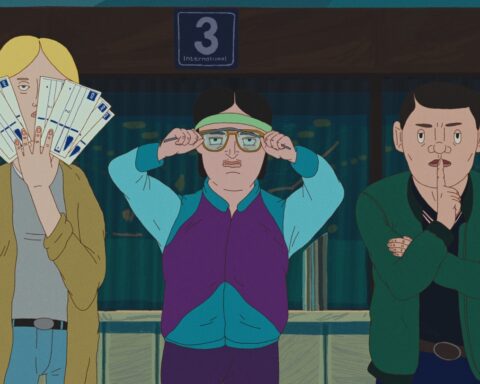Toxic Beauty
(Canada, 90 min.)
Dir. Phyllis Ellis
Programme: Special Presentations (World Premiere)
With all the doom and gloom environmental documentaries out there, many might have missed the greatest ecological disaster closest to home. For all the manufactured landscapes and rivers turned to toxic waste lands by chemical pollution, too little consideration (at least in the movies) has been paid to the harmful effects of the daily use of products that are killing the planet. Toxic Beauty sounds the alarm with an eye-opening exposé that some of the worst pollution happens in one’s own body. While not an “environmental film” per se, Toxic Beauty borrows from the canon of ecological wake-up calls that inspire some audience members to go green. Using a mix of hefty journalism and humanistic portraits, Toxic Beauty holds the cosmetics industry to account for polluting women’s bodies worldwide.
The doc, directed by Phyllis Ellis (Girls’ Night Out) and produced by Barri Cohen (who, full disclosure, is a columnist and former publisher of POV), fiercely opens audiences’ eyes to the fact that many personal care products are essentially cancer in a bottle. Toxic Beauty focuses on the landmark case in which South Dakotan Deane Berg (somewhat) successfully sued Johnson & Johnson after suspecting that sustained use of their baby powder caused the ovarian cancer that nearly took her life. The film takes a talking heads approach to convey the collective harm caused by companies like Johnson & Johnson that failed to adequately study their products, disclose their potentially harmful effects, or outright lied with rosy marketing campaigns that inspired consumers to think their products were safe. Berg’s story is just one among many, and she’s one of the lucky ones since she’s still alive.
The doc takes an inclusive and intersectional approach to its testimonials to explore how the cosmetics industry harms women from diverse backgrounds. Perhaps most compelling among the stories is that of Mel Lika, a former counterintelligence screener who used talcum powder for years. She speaks of her love of life, yet the camera perceives that her death is imminent. Ravaged by cancer, she struggles throughout the interviews as her memory fails and her body lags. A poignant shot of her napping during the shoot is evidence of just how cruel the practices of corporate greed can be.
Toxic Beauty adds some experts to the mix and approaches the problem from various points of view. Scientific testimonials back up the doc’s claims that seemingly innocuous products can be harmful when one uses them multiple times per day over a sustained period of time. Johnson & Johnson’s Baby Powder might be the focus of the film, and Berg’s case is an effectively convenient route with which to streamline the discussion while covering it in a meaningful way, but the problem is not unique to this one product. Talcum powder is a catalyst for a greater discussion about a multi-billion dollar industry that kills people.
The film draws upon this fact with a thread featuring young medical student Mymy Nguyen. Fun and bubbly, one doesn’t expect Nguyen to share her story about having a large tumour removed from her breast. She uses her wake-up call to explore the toxicity of the cosmetics she uses every day, like many women do, as she prepares for work or gets ready for a girls’ night out. She researches “clean” cosmetics and puts herself under the microscope by bringing samples of her “regular” products to a lab (named for Rachel Carson’s book Silent Spring, a nice nod to a woman who drew awareness to the practices of harmful chemicals decades ago) to see just much toxic crap is going into her body. The results are staggering, especially given how much Nguyen’s levels fluctuate when she switches from the products of her usual routine to clean cosmetics in just a day.
Nguyen and the women of Toxic Beauty situate their stories within the larger industrial practice that shape an idea of beauty used to commodify the female body. Toxic Beauty dives into the marketing spin that perpetuates ideas of fear and desirability that intimately link a woman’s body to her success. Archival infomercials show arcane practices of beautification that continue to this day, as the constructed ideal of femininity requires one toxic product after another. These snippets are uncannily reminiscent of Danishka Esterhazy’s recent sci-fi thriller Level 16, which featured a private school in which young women are farmed to give men products of eternally youthful beauty, and are humorous punctuation marks within a frequently heavy film.
Toxic Beauty spits in the face of the sanitized image of femininity that led to this situation. The doc illustrates how marketing myths are simply another form of misogyny against women’s bodies. The film empowers women to support companies and institutions that understand a woman’s right to feel beautiful without compromising her health. The call to action is one of consumer choice and education. Toxic Beauty doesn’t tell women to go home and raid their vanity kits, but it might inspire them to. It’s really asking women to show the world that beauty, intelligence, and resilience are not mutually exclusive.
Read more about Toxic Beauty in the feature When ‘Gentle’ Can Kill.
Visit hotdocs.ca and DOXAfestival.ca for showtimes.









